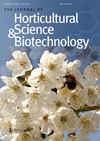施氮对“法国”李子树果实产量和品质的影响
IF 2.1
4区 农林科学
Q2 HORTICULTURE
Journal of Horticultural Science & Biotechnology
Pub Date : 1999-01-01
DOI:10.1080/14620316.1999.11511093
引用次数: 7
摘要
1991年,在一个3.6公顷的试验田上建立了滴灌施肥系统,以确定尿素施肥对“法国”李子树幼树生长响应和产量的影响。从1992年开始,每年施用氮肥(UN32),一直持续到1996年,每棵树的实际氮肥为0(对照)、0.11、0.23和0.45公斤,每两周施用,每次施用总量的十分之一,从5月到9月。如果7月叶氮分析显示总氮为2.3%或更低,则每年额外处理每棵树提供0.06 kg N,果实产量、每公斤果数、干燥比(每干果质量的新鲜果质量)、树木生长(树干截面积和修剪过的梢质量)、叶氮浓度和土壤硝酸盐含量作为处理的函数进行评估。在1994年和1996年以及三年平均水平上,施氮处理比对照提高了单株干产量。各年份氮肥处理对果实大小和干燥率无显著影响。当不施加N时,有w…本文章由计算机程序翻译,如有差异,请以英文原文为准。
EFFECTS OF NITROGEN FERTIGATION ON FRUIT YIELD AND QUALITY OF YOUNG 'FRENCH' PRUNE TREES
SummaryIn 1991, a 3.6 ha plot was established to determine the effects of urea fertigation via drip emitters on growth responses and yield of young `French' prune trees. Urea N (UN32) was applied annually beginning in 1992 and continuing through 1996 at 0 (control), 0.11, 0.23, and 0.45 kg actual N per tree as biweekly applications with one-tenth of the total amount per application from May until September. An additional annual treatment delivered 0.06 kg N per tree if July analysis of leaf N showed 2.3% or lower total N. Fruit yield, number of fruit per kilogram, drying ratio (fresh fruit mass per dry fruit mass), tree growth (trunk cross-sectional area and mass of pruned shoots), leaf N concentration, and soil nitrate content were assessed as a function of treatment. Dry yields per tree were increased by N treatments compared with the control in 1994 and 1996 and when averaged over three years. Fruit size and drying ratio were not affected by N treatments during any year. Where no N was applied, there w...
求助全文
通过发布文献求助,成功后即可免费获取论文全文。
去求助
来源期刊
CiteScore
3.90
自引率
5.30%
发文量
67
审稿时长
3 months
期刊介绍:
The Journal of Horticultural Science and Biotechnology is an international, peer-reviewed journal, which publishes original research contributions into the production, improvement and utilisation of horticultural crops. It aims to provide scientific knowledge of interest to those engaged in scientific research and the practice of horticulture. The scope of the journal includes studies on fruit and other perennial crops, vegetables and ornamentals grown in temperate or tropical regions and their use in commercial, amenity or urban horticulture. Papers, including reviews, that give new insights into plant and crop growth, yield, quality and response to the environment, are welcome, including those arising from technological innovation and developments in crop genome sequencing and other biotechnological advances.

 求助内容:
求助内容: 应助结果提醒方式:
应助结果提醒方式:


